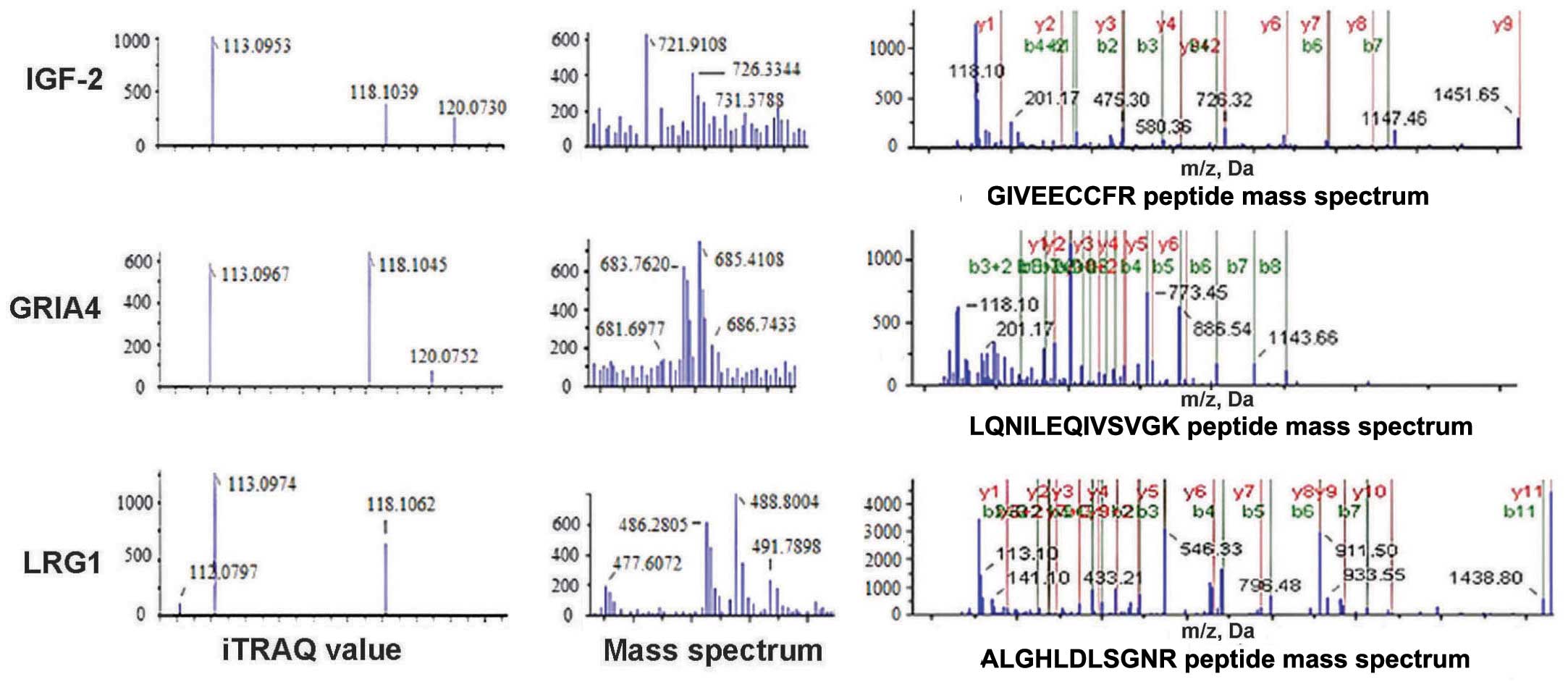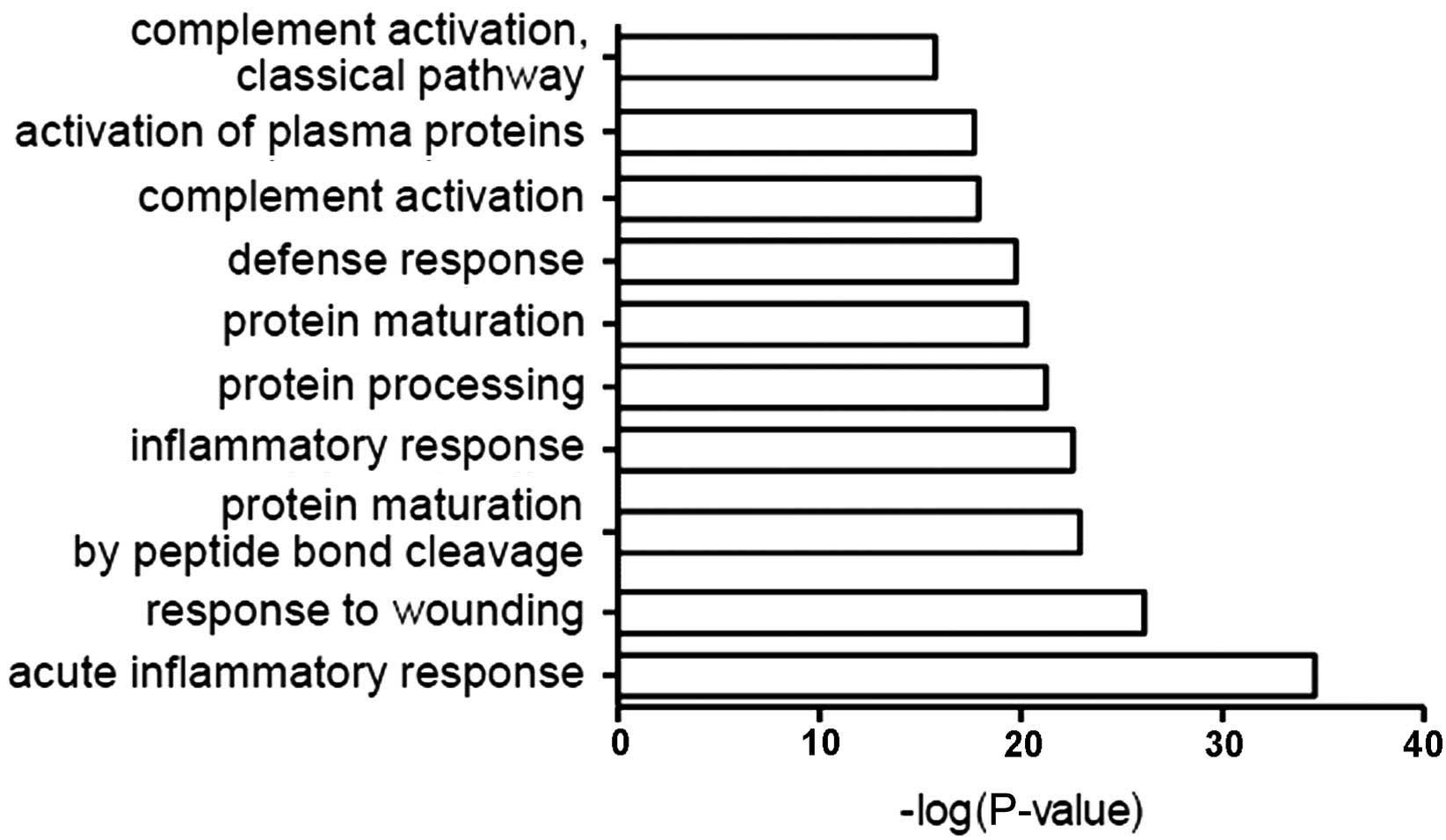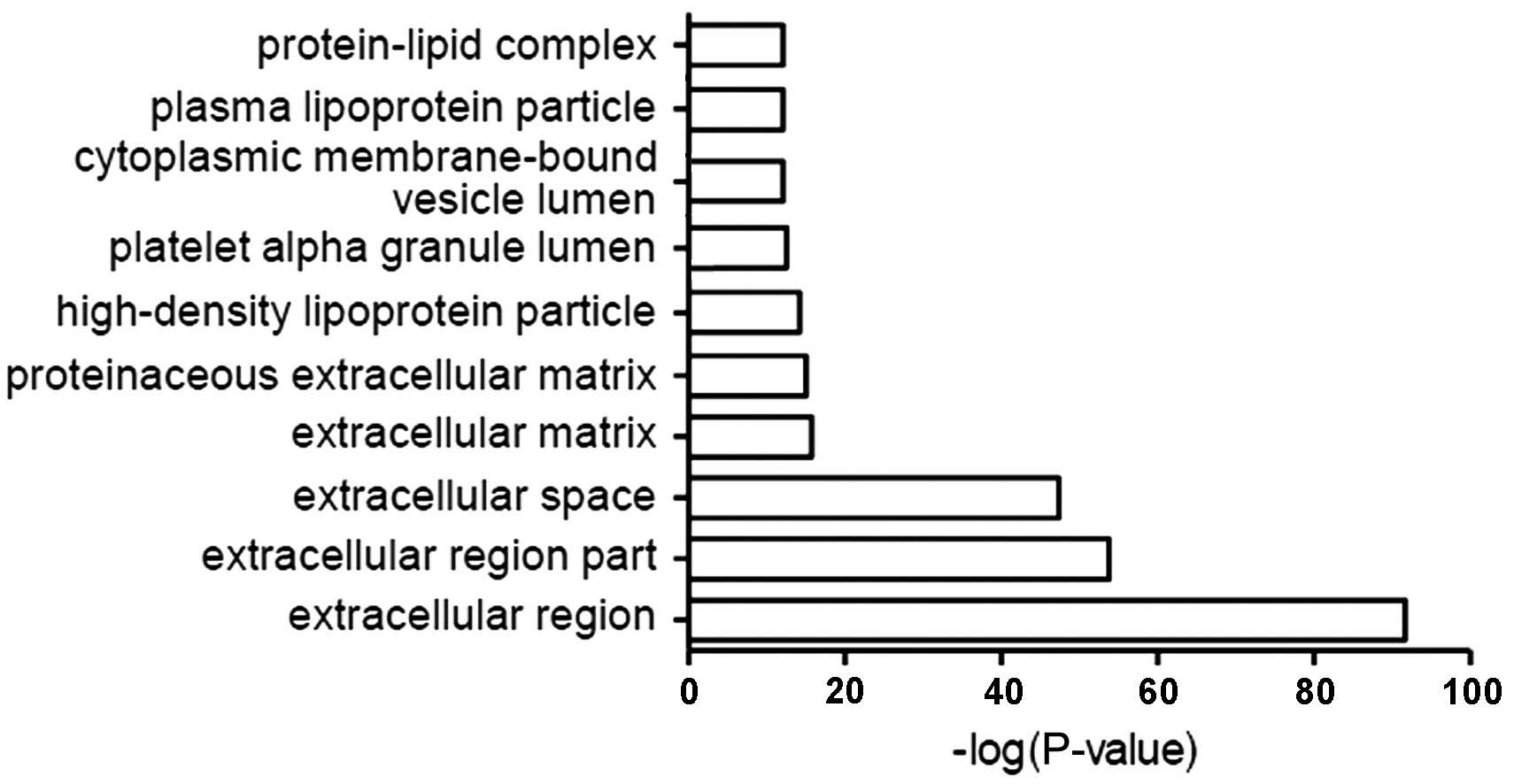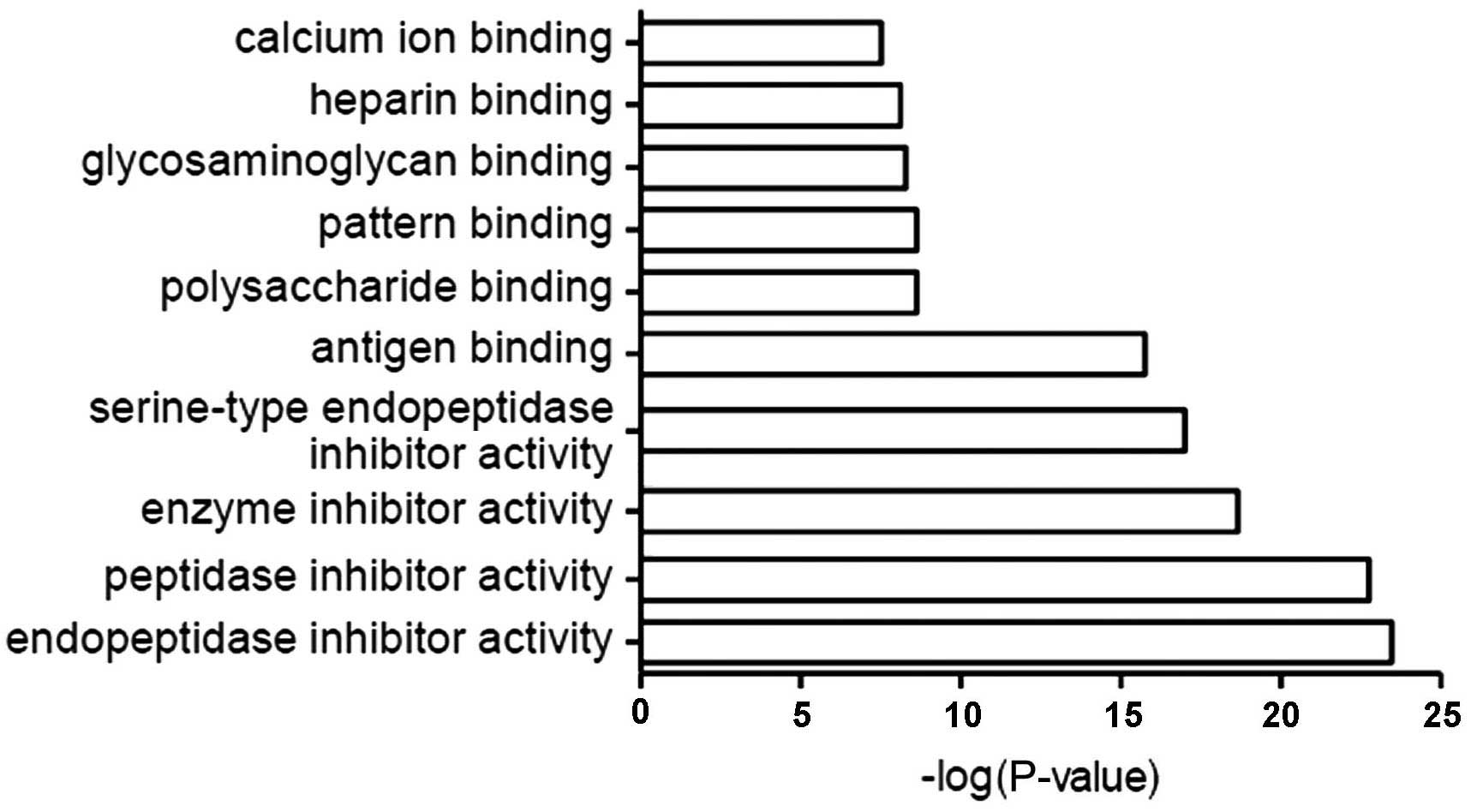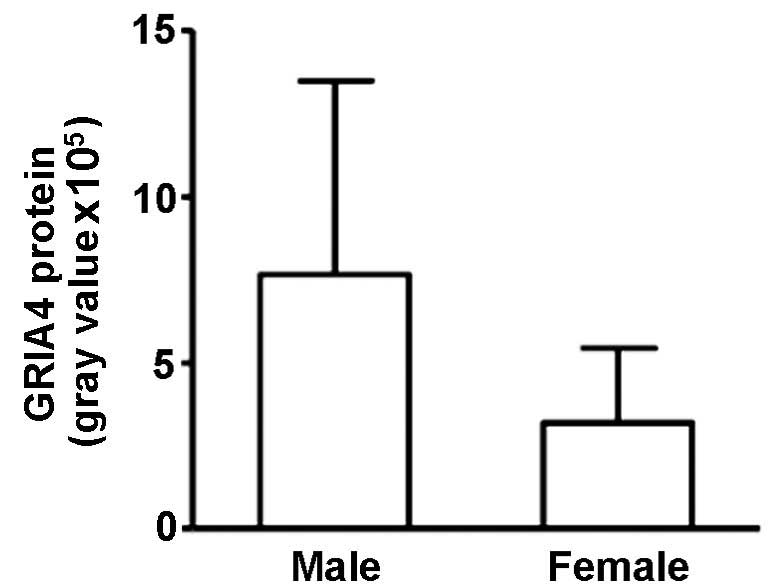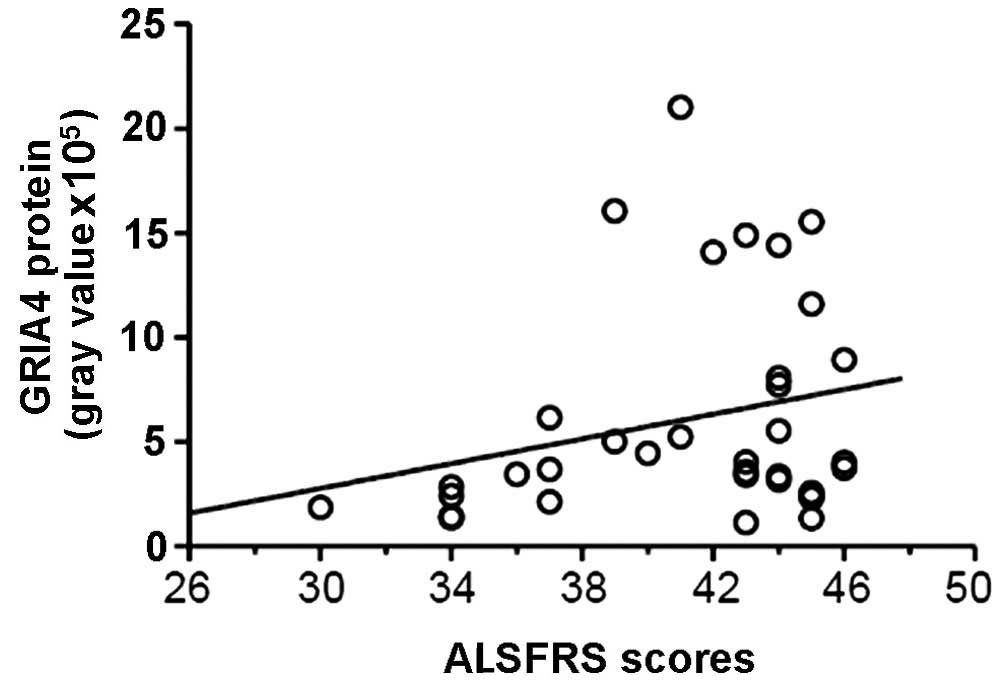Proteomic analysis of cerebrospinal fluid in amyotrophic lateral sclerosis
- Authors:
- Published online on: March 31, 2016 https://doi.org/10.3892/etm.2016.3210
- Pages: 2095-2106
-
Copyright: © Chen et al. This is an open access article distributed under the terms of Creative Commons Attribution License.
Abstract
Introduction
Amyotrophic lateral sclerosis (ALS) is a progressive neurodegenerative disease specifically affecting the upper and lower motor neurons. Due to frequent early misdiagnosis, patients do not benefit from early drug intervention and clinical drug studies have been largely unsuccessful; a correct, early diagnosis of ALS is therefore crucial.
Such a clinical diagnosis, and study of the pathogenesis of ALS, could occur through analysis of changes to the cerebrospinal fluid (CSF) proteins. Insulin-like growth factor-1, vascular endothelial growth factor, transactive response DNA-binding protein 43, monocyte chemotactic protein 1 and other proteins have been reported as possible diagnostic indicators of ALS (1–4), but a definitive diagnostic indicator has yet to be established.
CSF quantitative proteomics, including differential in gel electrophoresis (DIGE) and isotope-coded affinity tags, have been reported in studies on Alzheimer's disease and Parkinson's disease (5,6), but have not been widely used to investigate ALS. In 2005, a study by Ranganathan et al (7) was the first to investigate the CSF in ALS patients using surface-enhanced laser desorption/ionization (SELDI) technology and proteomics; three proteins, cystatin C, transthyretin and a carboxy-terminal fragment of the neuroendocrine protein 7B2, were screened and validated for their sensitivity and specificity as biomarkers. Other previous studies examined the CSF of ALS with two-dimensional gel electrophoresis, DIGE and SELDI (8,9), but use of isobaric tags for relative and absolute quantitation (iTRAQ) technology in this context has not been reported, to the best of our knowledge.
The present study compared the CSF protein expression of ALS patients and healthy [normal control [NC] group) patients using iTRAQ labeling and 2-dimensional liquid chromatography/tandem mass spectrometry (2D LC-MS/MS) technology, screened the resulting proteins and verified their differential expression by western blotting, in order to determine the most effective biomarkers for ALS diagnosis.
Patients and methods
Patients
ALS-A groupA total of 35 patients with ALS who presented to Huashan Hospital between March 2008 and October 2010 were selected for the study. Informed consent was obtained from all patients, or their families. Tension headache sufferers were selected as the normal control (NC) group. The other neurological disease (OND) group consisted of patients who, during clinical diagnosis, were subjected to a lumbar puncture; these patients suffered from conditions such as chronic non-inflammatory peripheral neuropathy, Parkinson's disease, spastic paraplegia and hydrocephalus. Patient ages ranged between 30 and 75 years old.
ALS-B groupA total of 10 cases of ALS were randomly selected from the ALS-A group and used to screen additional proteins.
CSF sample collectionUnder fasting conditions, each patient was treated with the 2 ml local anesthetic lidocaine hydrochloride injection (2%; Shanghai Harvest Pharmaceutical Co., Ltd., Shanghai, China) and subjected to a lumbar puncture, from which 8–10 ml of CSF was collected. A volume of 4–5 ml of CSF was immediately centrifuged at 2,000 × g for 10 min; the resulting supernatant was collected and placed in 1.5 ml Eppendorf tubes (Eppendorf AG, Hamburg, Germany) at −80°C. The remaining CSF was used for biochemical and immunological detection, as subsequently described.
Determination of protein concentration using iTRAQ and 2D LC-MS/MSFollowing the removal of 22 high-abundance proteins, including albumin and IgG, using ProteoMiner low abundance protein enrichment kits (Bio-Rad Laboratories, Inc., Hercules, CA, USA), protein quantification was conducted using a Protein Assay reagent kit (Bio-Rad Laboratories, Inc., Hercules, CA, USA) based on Bradford methods, according to manufacturer's protocol. iTRAQ labeling was performed according to the manufacturer's protocol (Applied Biosystems Life Technologies, Foster City, CA, USA). Briefly, 100 µg CSF proteins from the ALS and NC groups were precipitated with cold acetone (ratio of acetone:sample, 5:1) for 1 h at −20°C and resuspended in 20 µl dissolution buffer, respectively. Following centrifugation at 2,000 × g for 15 min and disposal of the supernatant, the precipitant was dissolved into 20 ul iTRAQ solution and 1 ul 1% sodium dodecyl sulfate (SDS). Subsequently, 1 ul cysteine sealing reagent was added for 10 min at room temperature. Proteins were trypsinized (Sigma-Aldrich, St. Louis, MO, USA) at 37°C overnight (ratio of enzyme:protein, 1:20). Peptides were labeled with iTRAQ regents for 1 h at room temperature. iTRAQ regents 113 and 118 were used to label the peptides from the NC and ALS groups, respectively. Following this, samples were mixed, desalted with Sep-Pak Vac C18 cartridges (Waters Corporation, Milford, MA, USA) and dried in a vacuum concentrator.
2D LC-MS/MS analysisHigh-performance liquid chromatography and time-of-flight mass spectrometry (API QSTAR XL Hybrid LC-MS/MS; Applied Biosystems Life Technologies) were used for protein separation and analysis. For 2D LC-MS/MS analysis, the iTRAQ-labeled mixed peptides were fractionated using strong cation exchange (SCX) chromatography on a 20AD HPLC system (Shimadzu Corporation, Kyoto, Japan) with a polysulfoethyl column (2.1×100 mm; 5 µm; 200 Å; The Nest Group, Inc., Southborough, MA, USA). Peptide mixture was reconstituted in Buffer A (SCXA), which contained 10 mM KH2PO4 in 25% acetonitrile (pH 2.6; Thermo Fisher Scientific, Waltham, MA, USA), and loaded onto the column. Peptides were separated at a flow rate of 200 µl/min for 60 min with a gradient of 0–80% Buffer B (Buffer A supplemented with 350 mM KCl) in Buffer A. Absorbances of 214 nm and 280 nm were identified by tandem mass spectrometry. A total of 20 SCX fractions were collected.
Protein identificationAll data from tandem mass spectrometry were obtained from the UniProtKB/Swiss-Prot database using ProteinPilot 3.0 software (AB Sciex, Framingham, MA, USA), and the identification and quantification results were recorded. Search parameters were as follows: At least 1 matching peptide, a confidence interval (CI) of the peptide of >95% (P<0.05) and results in accordance with the peak of the spectrum.
Protein annotation and classificationThe Database for Annotation, Visualization and Integrated Discovery (DAVID) was used for functional annotation of proteins and gene ontology (GO) was used to classify these proteins, including their involvement in biological processes, as cellular components and their molecular function.
Differential expression of proteinsWestern blotting was performed to analyze differential protein expression in the CSF between the ALS-B and NC groups, in order to verify the iTRAQ results. A total of 1 ml CSF sample was added into a 3 kD ultrafiltration centrifugal tube (EMD Millipore, Billerica, CA, USA) for desalination and concentration. Protein concentrations were subsequently measured via the Bradford method using Bio-Rad protein assay reagent (Bio-Rad Laboratories, Inc.). A total of 20 µg protein was separated by 12% SDS polyacrylamide gel electrophoresis followed by electro-blotting onto a polyvinylidene difluoride membrane. The membrane was subsequently incubated with 5% nonfat dry milk in Tris-buffered saline at room temperature for 2 h, in order to block non-specific binding. Following this, the membrane was incubated with the following primary antibodies: Rabbit anti-human insulin-like growth factor II (IGF-2; l:1,250; ab9574); mouse anti-human leucine-rich α-2-glycoprotein 1 (LRG1; l:800; ab57992); and rabbit anti-human glutamate receptor 4 (GRIA4; 1:500; ab61171; all Abcam, Cambridge, UK), diluted in blocking buffer overnight at 4°C. The membrane was subsequently incubated with horseradish peroxidase-conjgated AffinPure goat anti-rabbit (KC-RB-035) and anti-mouse (KC-MM-035) immunoglobulin G (H+L) secondary antibodies (both 1:5,000; Shanghai Kangcheng Biotechnology Co., Ltd., Shanghai, China) diluted with nonfat dry milk and Tris-buffered saline and Tween 20 (TBST). After rinsing three times with TBST, the western blot protein band was detected using chemiluminescence, and the gray scales of the bands were quantified using software Image Lab 3.0 (Bio-Rad Laboratories, Inc.).
Statistical analysisSPSS17.0 (SPSS, Inc., Chicago, IL, USA) was used for statistical analyses, GraphPad Prism 4 (GraphPad Software, Inc., La Jolla, CA, USA) was used to draw graphs and ProteinPilot 3.0 was used to detect the protein threshold [where Unused ProtScore >1.3 (95% CI)]. An error (ProtScore) of 2.0 indicated a credible identified protein; an error of >1.2 or <0.8 indicated an identifiable significant difference (P<0.05).
All data were normally distributed when examined with a one-sample Kolmogorov-Smirnov test. A t-test was used to compare two groups and data are expressed as the mean ± standard deviation; P<0.05 was considered to indicate a statistically significant difference.
Correlation analysis used multiple linear regression analysis and the disaggregated data was assigned a conversion score, as follows: i) Gender: male, 1; and female, 2; ii) diagnostic level: diagnosed, 1; suspected, 2; suspected and clinically supported, 3; iii) involvement: medullary, 1; cervical, 2; and lumbar, 3.
Results
Clinical data
The average ages of the ALS-B and NC groups were 52.7±12.13 and 51.1±10.62 years old, respectively, and there were 6 men and 4 women in each group. No significant difference in age or gender balance between these groups was identified (P>0.05).
The average ages of the ALS-A and OND groups were 52.80±11.98 and 51.17±12.44 years old, respectively, and there were 22 men and 13 women in the ALS-A group, and 11 men and 7 women in the OND group. No significant difference was identified in age or gender balance between these groups (P>0.05). The protein concentration of CSF was 350.46±110.09 mg/l in the ALS-A group and 377.56±85.85 mg/l in the control group, with no significant difference revealed between the two (P>0.05).
CSF protein identification
iTRAQ and 2D-LC-MS/MS analyses were performed and used to analyze the protein content of the CSF in the ALS and NC groups. A total of 248 proteins were identified, and their names, the iTRAQ ratio (where available) and the UniProtKB/Swiss-Prot database accession number of 243 of these proteins are provided (95% CI; Tables I and II).
Analyses of differential protein expression
A total of 35 differentially-expressed proteins were compared between the ALS and NC groups; of these, 14 were upregulated and 21 were downregulated (Tables III and IV). These proteins had a ProtScore between the values of >1.2 and <0.8, corresponding to P<0.05.
Sample data of specific differentially-expressed proteins
IGF-2 and LRG1 protein expression was decreased in the experimental groups, whereas GRIA4 expression was increased (Fig. 1).
DAVID results and the classification of proteins by biological role
The function of all identified proteins was analyzed using GO in conjunction with DAVID software. The most common biological roles of CSF proteins were in acute inflammation, damage response, protein maturation, inflammation, defense response, complement activation and other associated immune pathways (Fig. 2).
Classification by cellular localization
The most common localization of CSF proteins relative to cells included the extracellular domain, extracellular space, extracellular matrix and protein-lipid complexes (Fig. 3).
Classification by molecular function
The most common molecular functions of CSF proteins were endopeptidase, peptidase, enzyme and serine-type endopeptidase inhibitors, and antigen-, calcium- and heparin-binding proteins (Fig. 4).
Western blotting
A total of 3 candidate proteins were randomly selected to be examined by western blot analysis in the ALS and the NC groups (Fig. 5); of these, IGF-2 was revealed to be significantly downregulated and GRIA4 was significantly upregulated in the ALS group when compared with the normal control group (P<0.05; Table V), but LRG1 expression was not significantly altered (P=0.224; Table V). These proteins were also examined by western blot analysis in the ALS-A and OND groups, again demonstrating a significant downregulation of IGF-2 and a significant upregulation of GRIA4 in the ALS group compared with the OND group (P<0.01; Table VI), but no significant difference in LRG1 expression between these groups (P=0.196; Table VI).
Correlation between GRIA4 and gender
GRIA4 expression in the ALS-A group was significantly higher in male patients than in female patients (765,483±583,227 and 319,766±224,242, respectively; r=−0.574; P=0.003; Fig. 6).
GRIA4 expression in the ALS-A group was also positively correlated with ALS clinical scores (r=0.487; P=0.017), indicating a negative correlation with clinical severity (Fig. 7).
Discussion
In the present study, 248 different low-abundance proteins were identified in human CSF and the details of these proteins were established in ALS patients. All proteins were subjected to GO analysis with DAVID software and were classified according to their involvement in biological processes, their cellular localization and their molecular function. Data indicated that the primary roles of these proteins were in the acute inflammatory response and injury response, that the proteins were predominantly localized to extracellular regions and that the majority of these proteins were endopeptidase and peptidase inhibitors. These data aid the understanding of CSF protein profiles in patients with ALS, and provide possible biomarkers of the disease. A screening of 35 of these proteins revealed significant differences in protein expression between the ALS and NC groups, primarily in inflammation-associated proteins, neurotrophic factors and signal transduction proteins.
IGF-2, GRIA4 and LRG1 were randomly selected to verify their differential expression in ALS patients using western blot analysis. Consistent with the results of the proteomic analysis, IGF-2 and GRIA4 expression was altered in the CSF of ALS patients, but there was no significant difference in LRG1 expression between the ALS and NC groups; this led to the conclusion that additional verification of the altered protein expression reported in the present study is necessary to confirm these proteomic results.
To confirm the expression specificity of IGF-2, GRIA4 and LRG1, expression levels of these proteins were compared in patients with ALS and patients with OND; IGF-2 expression was significantly decreased, but GRIA4 expression was significantly increased.
Alterations to protein expression are complex with regard to disease progression, age, gender and duration of illness; it was thus important to examine the correlation between alterations to protein expression and clinical features. Clinical data of 35 ALS patients was collected and were subjected to multiple linear regression analysis to reveal any confounding factors.
The clinical data in the present study revealed a higher male incidence of ALS (male to female ratio, 1.7:1), which was in support of a previous study; the 2009 European epidemiological study revealed a similar ratio of 1.4:1 (10). The present results demonstrated a correlation of GRIA4 expression with gender; male GRIA4 levels were 2.5-fold those of female levels (P<0.01).
To the best of our knowledge, the association between glutamate receptor levels and clinical characteristics has not been studied; however, glutamate excitotoxicity damage is widely recognized in the pathogenesis of ALS. Fiszman et al (11) reported no significant correlation between glutamate ligand concentration in the CSF of patients with different severities of ALS, suggesting that glutamate is involved in the occurrence of ALS and not in the severity of the disease. Excitotoxicity of glutamate also requires the presence of a glutamate receptor, meaning that high expression of glutamate receptors may be responsible for the neuronal toxicity injury induced by glutamate. As the concentration of glutamate is increased in the CSF of ALS patients (11), and GRIA4 expression was increased in ALS in the current study, the high incidence of ALS may be associated with the expression of GRIA4.
In the present study, the ALS score was estimated using the ALSFRS-R scale; a lower score on this scale corresponded to more severe disease. A multivariate analysis indicated that GRIA4 expression was positively correlated with the ALS score, revealing a negative correlation with the severity of the disease. However, ALS patients with mild symptoms were selected, defined in accordance with a previous scoring system attributing a score >25 to less severe ALS and scores of <25 to moderate and severe phases of ALS (12). As the glutamate concentration is significantly increased in the CSF of ALS patients (7), glutamate is likely to be involved in the pathogenesis of the disease. From the present results, it was concluded that GRIA4 expression is likely to be involved in the pathogenesis of ALS, resulting in a negative feedback regulatory mechanism to subsequently reduce its expression. The glutamate receptor antagonist, riluzole, is effective in the early treatment of ALS (13). In conjunction with the present report suggesting the early-stage overexpression of GRIA4, these data indicate that early treatment with anti-glutamate-associated drugs may prove a useful therapeutic measure.
The multivariate analysis examining IGF-2 and LRG1 expression and the clinical data revealed no significant correlations. This may be attributable to the sample size of the present study being too small or too few clinical factors being included. Based on the standard deviation values, the expression levels of IGF-2 and LRG1 were relatively balanced, as compared with the standard deviation of the GRIA4 expression levels, which suggested that IGF-2 may be a valuable biomarker of ALS with higher credibility due to fewer interference factors.
In summary, GRIA4 expression varied based on gender and may be reflective of ALS severity, providing a meaningful reference value for the timing of treatment. Furthermore, IGF-2 may prove an effective diagnostic marker of ALS.
Acknowledgements
The present study was supported by the Scientific Research Foundation of Huashan Hospital, Fudan University (Dr Yan Chen; 2007). The authors would like to thank staff from the Institute of Biomedical Science (Fudan University, Shanghai, China) for providing technical support.
References
|
Corbo M, Lunetta C, Magni P, Dozio E, Ruscica M, Adobbati L and Silani V: Free insulin-like growth factor (IGF)-1 and IGF-binding proteins-2 and −3 in serum and cerebrospinal fluid of amyotrophic lateral sclerosis patients. Eur J Neurol. 17:398–404. 2010. View Article : Google Scholar : PubMed/NCBI | |
|
Devos D, Moreau C, Lassalle P, Perez T, De Seze J, Brunaud-Danel V, Destée A, Tonnel AB and Just N: Low levels of the vascular endothelial growth factor in CSF from early ALS patients. Neurology. 62:2127–2129. 2004. View Article : Google Scholar : PubMed/NCBI | |
|
Kasai T, Tokuda T, Ishigami N, Sasayama H, Foulds P, Mitchell DJ, Mann DM, Allsop D and Nakagawa M: Increased TDP-43 protein in cerebrospinal fluid of patients with amyotrophic lateral sclerosis. Acta Neuropathol. 117:55–62. 2009. View Article : Google Scholar : PubMed/NCBI | |
|
Nagata T, Nagano I, Shiote M, Narai H, Murakami T, Hayashi T, Shoji M and Abe K: Elevation of MCP-1 and MCP-1/VEGF ratio in cerebrospinal fluid of amyotrophic lateral sclerosis patients. Neurol Res. 29:772–776. 2007. View Article : Google Scholar : PubMed/NCBI | |
|
Zhang J, Goodlett DR, Quinn JF, Peskind E, Kaye JA, Zhou Y, Pan C, Yi E, Eng J, Wang Q, et al: Quantitative proteomics of cerebrospinal fluid from patients with Alzheimer disease. J Alzheimers Dis. 7:125–133; discussion 173–180. 2005.PubMed/NCBI | |
|
Jin J, Meredith GE, Chen L, Zhou Y, Xu J, Shie FS, Lockhart P and Zhang J: Quantitative proteomic analysis of mitochondrial proteins: Relevance to Lewy body formation and Parkinson's disease. Brain Res Mol Brain Res. 134:119–138. 2005. View Article : Google Scholar : PubMed/NCBI | |
|
Ranganathan S, Williams E, Ganchev P, Gopalakrishnan V, Lacomis D, Urbinelli L, Newhal K, Cudkowicz ME, Brown RH Jr and Bowser R: Proteomic profiling of cerebrospinal fluid identifies biomarkers for amyotrophic lateral sclerosis. J Neurochem. 95:1461–1471. 2005. View Article : Google Scholar : PubMed/NCBI | |
|
Ryberg H, An J, Darko S, Lustgarten JL, Jaffa M, Gopalakrishnan V, Lacomis D, Cudkowicz M and Bowser R: Discovery and verification of amyotrophic lateral sclerosis biomarkers by proteomics. Muscle Nerve. 42:104–111. 2010. View Article : Google Scholar : PubMed/NCBI | |
|
Ekegren T, Hanrieder J and Bergquist J: Clinical perspectives of high-resolution mass spectrometry-based proteomics in neuroscience: Exemplified in amyotrophic lateral sclerosis biomarker discovery research. J Mass Spectrom. 43:559–571. 2008. View Article : Google Scholar : PubMed/NCBI | |
|
Logroscino G, Traynor BJ, Hardiman O, Chiò A, Mitchell D, Swingler RJ, Millul A, Benn E and Beghi E: EURALS: Incidence of amyotrophic lateral sclerosis in Europe. J Neurol Neurosurg Psychiatry. 81:385–390. 2009. View Article : Google Scholar : PubMed/NCBI | |
|
Fiszman ML, Ricart KC, Latini A, Rodríguez G and Sica RE: In vitro neurotoxic properties and excitatory aminoacids concentration in the cerebrospinal fluid of amyotrophic lateral sclerosis patients. Relationship with the degree of certainty of disease diagnoses. Acta Neurol Scand. 121:120–126. 2010. View Article : Google Scholar : PubMed/NCBI | |
|
Iłzecka J: Cerebrospinal fluid Flt3 ligand level in patients with amyotrophic lateral sclerosis. Acta Neurol Scand. 114:205–209. 2006. View Article : Google Scholar : PubMed/NCBI | |
|
Miller RG, Mitchell JD, Lyon M and Moore DH: Riluzole for amyotrophic lateral sclerosis (ALS)/motor neuron disease (MND). Cochrane Database Syst Rev. 1:CD0014472007.PubMed/NCBI |



